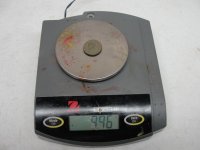paleomaxx
Hero Member
- Aug 14, 2016
- 841
- 6,887
- 🥇 Banner finds
- 6
- Detector(s) used
- Deus XP
- Primary Interest:
- All Treasure Hunting
Seriously, never though I would dig one of these in a million years. Certainly not in Massachusetts of all places! I was at an old 1750's house and after a couple dozen of the usual late 18th to late 19th century targets I finally get a big old copper tone and in the plug is a fat green rim. Looked a lot like a George I halfpenny before the dirt came off, but nope:
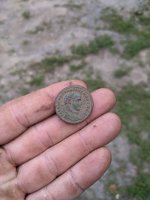
1700 year old Roman Coin!!! That Maine penny has nothing on this; someone phone National Geographic!
Yeah I know, more recent loss, but still shocking to see out of the soil. It's in superb shape too. It was on a hillside and the soil was almost pure sand so what little patina is on there may be from the original burial over in Europe.
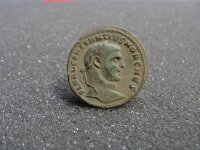
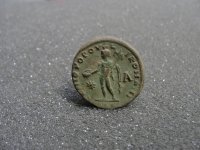
Granted I'm far from an expert in Roman coins but I believe it's Constantine the Great and then on the reverse is Genius standing left, holding a patera and cornucopia. All the lettering is well struck and bold except for the mintmark, which figures. I think it's ALE for Alexandria but it really is nearly completely missing. I haven't been able to find an exact match for this issue and stranger still is that "POPVLI" has an extra "O" making "POPOVLI." Ancient typo?
I'm pretty sure this was a souvenir brought back from WWII. Not even two feet away I found a child's pewter army man and the person who lived at this house between the 1930's and 1980's served in the army during WWII. He passed away in 1992 so I'm still trying to find his exact service history but if he participated in the Liberation of Italy (or really anywhere in the European theater) then it's a good bet that he picked it up for his kid and the kid dropped it in the yard some time later. At any rate, a find of a lifetime for a New England detectorist and in fantastic shape to boot! I expect this will be a good conversation piece for years to come.
Any further insight into the coin itself would be appreciated, I gather that the bearded busts correspond to the earlier years of his rule, but I don't know if that's a firm rule or just a general one.
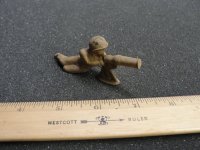

1700 year old Roman Coin!!! That Maine penny has nothing on this; someone phone National Geographic!

Yeah I know, more recent loss, but still shocking to see out of the soil. It's in superb shape too. It was on a hillside and the soil was almost pure sand so what little patina is on there may be from the original burial over in Europe.


Granted I'm far from an expert in Roman coins but I believe it's Constantine the Great and then on the reverse is Genius standing left, holding a patera and cornucopia. All the lettering is well struck and bold except for the mintmark, which figures. I think it's ALE for Alexandria but it really is nearly completely missing. I haven't been able to find an exact match for this issue and stranger still is that "POPVLI" has an extra "O" making "POPOVLI." Ancient typo?

I'm pretty sure this was a souvenir brought back from WWII. Not even two feet away I found a child's pewter army man and the person who lived at this house between the 1930's and 1980's served in the army during WWII. He passed away in 1992 so I'm still trying to find his exact service history but if he participated in the Liberation of Italy (or really anywhere in the European theater) then it's a good bet that he picked it up for his kid and the kid dropped it in the yard some time later. At any rate, a find of a lifetime for a New England detectorist and in fantastic shape to boot! I expect this will be a good conversation piece for years to come.

Any further insight into the coin itself would be appreciated, I gather that the bearded busts correspond to the earlier years of his rule, but I don't know if that's a firm rule or just a general one.

Upvote
43




